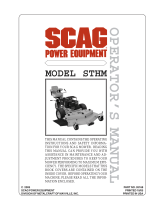
4
BEFORE OPERATING
1. Know the controls and how to stop quickly.
2. Do not allow children to operate the machine.
Do not allow adults to operate the machine
without proper instruction.
3. Remove all debris or other objects that might be
picked up and thrown by the cutter blades. Keep
all bystanders away from the mowing area.
4. Keep all shields, safety devices, and decals in
place. If a shield, safety device or decal is
defective or damaged, repair or replace it before
operating. Also, check all nuts, bolts and screws
for proper tightness, to assure the machine is in
safe operating condition.
5. Do not operate the machine while wearing
sandals, tennis shoes, sneakers or shorts. Also,
do not wear loose fitting clothing which could
get caught in moving parts. Always wear long
pants and substantial shoes. Wearing safety
glasses and safety shoes is advisable and required
by some local ordinances and insurance regula-
tions.
6. Fill the fuel tank with clean, fresh gasoline, with
a minimum octane rating of 87. Avoid spilling
gasoline. Gasoline is highly flammable, handle it
carefully.
A. Use an approved gasoline container.
B. Do not fill the tank while the engine is hot or
running.
C. Do not smoke while handling gasoline.
D. Fill the fuel tank outdoors and up to approxi-
mately 1" (25 mm) below the bottom of the
filler neck.
E. Wipe up any spilled gasoline.
7. Before attempting to start the engine, move the
speed adjustment lever into the neutral position,
move the blade engagement switch to the OFF
position, apply the parking brake, and move the
neutral latches to neutral.
WHILE OPERATING
1. Start the engine when the neutral latches are in
the neutral lock position, the cutter blades are
disengaged, the parking brake is on and the
speed adjustment lever is in the neutral position.
2. Do not run the engine in a confined area without
adequate ventilation. Exhaust fumes are hazard-
ous and could possibly be deadly.
3. Using the machine demands attention. To
prevent loss of control:
A. Mow only in daylight or when there is good
artificial light.
B. Watch for holes or other hidden hazards.
C. Do not drive close to a drop-off, ditch, creek
bank, or other hazard.
D. Reduce speed when making sharp turns and
when turning on hillsides.
E. Always be sure of your footing. Keep a firm
hold on the handles and walk---never run.
F. Do not operate where conditions are slippery.
4. The discharge chute must always be installed and
in the down position on the side discharge cutter
deck except when the Scag optional grass
catcher or mulching plate are properly installed.
If the discharge area should plug, shut the engine
off and wait for all movement to stop before
removing the obstruction.
5. Disengage the blades and wait for them to stop
before crossing gravel drives, walks or roads.
6. Shut the engine off and wait until the blades
come to a complete stop before removing the
grass catcher container.
7. Never raise the cutter deck while the blades are
rotating.
8. Always park the mower and/or start the engine
on a level surface. Apply the parking brake to
prevent the mower from moving when you are
not in the operator’s position.



























